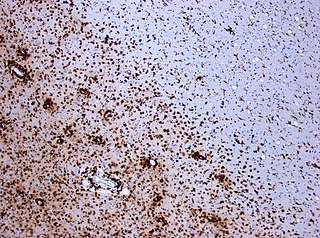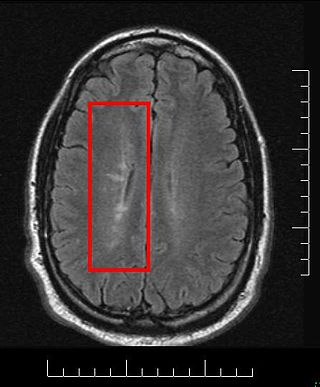Related Research Articles

Multiplesclerosis (MS) is the most common demyelinating disease,in which the insulating covers of nerve cells in the brain and spinal cord are damaged. This damage disrupts the ability of parts of the nervous system to transmit signals,resulting in a range of signs and symptoms,including physical,mental,and sometimes psychiatric problems. Specific symptoms can include double vision,blindness in one eye,muscle weakness,and trouble with sensation or coordination. MS takes several forms,with new symptoms either occurring in isolated attacks or building up over time. In the relapsing forms of MS,between attacks,symptoms may disappear completely,although some permanent neurological problems often remain,especially as the disease advances.

The McDonald criteria are diagnostic criteria for multiple sclerosis (MS). These criteria are named after neurologist W. Ian McDonald who directed an international panel in association with the National Multiple Sclerosis Society (NMSS) of America and recommended revised diagnostic criteria for MS in April 2001. These new criteria intended to replace the Poser criteria and the older Schumacher criteria. They have undergone revisions in 2005,2010 and 2017.

Multiple sclerosis and other demyelinating diseases of the central nervous system (CNS) produce lesions and glial scars or scleroses. They present different shapes and histological findings according to the underlying condition that produces them.
Inflammatory demyelinating diseases (IDDs),sometimes called Idiopathic (IIDDs) due to the unknown etiology of some of them,are a heterogenous group of demyelinating diseases - conditions that cause damage to myelin,the protective sheath of nerve fibers - that occur against the background of an acute or chronic inflammatory process. IDDs share characteristics with and are often grouped together under Multiple Sclerosis. They are sometimes considered different diseases from Multiple Sclerosis,but considered by others to form a spectrum differing only in terms of chronicity,severity,and clinical course.

Laquinimod is an experimental immunomodulator developed by Active Biotech and Teva. It is being investigated as an oral treatment for multiple sclerosis (MS).
A clinically isolated syndrome (CIS) is a clinical situation of an individual's first neurological episode,caused by inflammation or demyelination of nerve tissue. An episode may be monofocal,in which symptoms present at a single site in the central nervous system,or multifocal,in which multiple sites exhibit symptoms. CIS with enough paraclinical evidence can be considered as a clinical stage of multiple sclerosis (MS). It can also be retrospectively diagnosed as a kind of MS when more evidence is available.
Burton Drayer,MD,FACR,FANN,is an American radiologist and nationally recognized authority on the use of computed tomography and magnetic resonance imaging for diagnosing neurological disorders. From 2003 to 2008,he served as president,The Mount Sinai Hospital. As of 2020,he is the Charles M. and Marilyn Newman Professor and System Chair,Radiology,for The Mount Sinai Health System and Ican School of Medicine at Mount Sinai Hospital in New York City.
Schumacher criteria are diagnostic criteria that were previously used for identifying multiple sclerosis (MS). Multiple sclerosis,understood as a central nervous system (CNS) condition,can be difficult to diagnose since its signs and symptoms may be similar to other medical problems. Medical organizations have created diagnostic criteria to ease and standardize the diagnostic process especially in the first stages of the disease. Schumacher criteria were the first internationally recognized criteria for diagnosis,and introduced concepts still in use,as CDMS.

Current standards for diagnosing multiple sclerosis (MS) are based on the 2018 revision of McDonald criteria. They rely on MRI detection of demyelinating lesions in the CNS,which are distributed in space (DIS) and in time (DIT). It is also a requirement that any possible known disease that produces demyelinating lesions is ruled out before applying McDonald's criteria.

Stephen L. Hauser is a professor of the Department of Neurology at the University of California,San Francisco (UCSF). His work specializes on immune mechanisms and multiple sclerosis (MS). He has contributed to the establishment of consortia that have identified more than 50 gene variants that contribute to MS risk.

Val Murray Runge is an American and Swiss professor of radiology and the editor-in-chief of Investigative Radiology. Runge was one of the early researchers to investigate the use of gadolinium-based contrast agents for magnetic resonance imaging (MRI),giving the first presentation in this field,followed two years later by the first presentation of efficacy. His research also pioneered many early innovations in MRI,including the use of tilted planes and respiratory gating. His publication on multiple sclerosis in 1984 represented the third and largest clinical series investigating the role of MRI in this disease,and the first to show characteristic abnormalities on MRI in patients whose CT was negative.
Hermanus Johannes "Herman J." Adèr is a Dutch statistician/methodologist and consultant at the Vrije Universiteit,the VU University Medical Center and the University of Stavanger,known for work on Methodological Modelling and Social Research Methodology.

Multiple sclerosis (MS) can be pathologically defined as the presence of distributed glial scars (scleroses) in the central nervous system that must show dissemination in time (DIT) and in space (DIS) to be considered MS lesions.

David A. Hafler is an American neurologist. He is the Edgerly Professor and chairman of the department of Neurology at the Yale School of Medicine. He is known for his work in immunity,genetics,and multiple sclerosis. In 2018 he was elected to the National Academy of Medicine.

Howard L. Weiner is an American neurologist,neuroscientist and immunologist who is also a writer and filmmaker. He performs clinical and basic research focused on multiple sclerosis (MS) and other neurologic diseases such as Alzheimer’s Disease and Lou Gehrig’s Disease (ALS). His work also focuses on autoimmune diseases such as diabetes. Weiner is the Robert L. Kroc Professor of Neurology at Harvard Medical School,director of the Brigham MS Center at the Brigham and Women’s Hospital and co-director of the Ann Romney Center for Neurologic Diseases established in 2014,at the Brigham and Women’s Hospital in Boston,Massachusetts.

Philip Scheltens is a Dutch professor of neurology and founder of the Alzheimer Centre,VU University Medical Center Amsterdam.

David Alastair Standish Compston is Emeritus professor of Neurology in the Department of Clinical Neurosciences at the University of Cambridge and an Emeritus Fellow of Jesus College,Cambridge.
Radiologically isolated syndrome (RIS) is a clinical situation in which a person has white matter lesions suggestive of multiple sclerosis (MS),as shown on an MRI scan that was done for reasons unrelated to MS symptoms. The nerve lesions in these people show dissemination in space with an otherwise normal neurological examination and without historical accounts of typical MS symptoms.
Anne Cross is an American neurologist and neuroimmunologist and the Section Head of Neuroimmunology at Washington University School of Medicine in St. Louis,Missouri. Cross holds the Manny and Rosalyn Rosenthal–Dr. John L. Trotter Endowed Chair in Neuroimmunology at WUSTL School of Medicine and co-directs the John L Trotter Multiple Sclerosis Clinic at Barnes-Jewish Hospital. Cross is a leader in the field of neuroimmunology and was the first to discover the role of B cells in the pathogenesis of multiple sclerosis in animals and then in humans. Cross now develops novel imaging techniques to observe inflammation and demyelination in the central nervous systems of MS patients for diagnosis and disease management.
Alan J. Thompson,MD,FMedSci,FRCP,FRCPI,is Dean of the Faculty of Brain Sciences at UCL;Pro-Provost for London at UCL;Garfield Weston Professor of Clinical Neurology and Neurorehabilitation at the UCL Queen Square Institute of Neurology. He is also a consultant neurologist at the University College London NHS Hospitals Foundation Trust working at the National Hospital for Neurology and Neurosurgery. He is Editor-in-Chief for Multiple Sclerosis Journal.
References
- ↑ "Barkhof, Frederik, 1962-". id.loc.gov. Retrieved May 19, 2021.
- 1 2 "Biography Frederik Barkhof, MD, PhD" (PDF). ectrims-congress.eu. Retrieved May 19, 2021.
- ↑ Barkhof, Frederik; Filippi, M.; Miller, D.H.; Scheltens, P.; Campi, A.; Polman, C.H.; Comi, G.; Adèr, H.J.; Losseff, N.; Valk, J. (November 1997). "Comparison of MRI criteria at first presentation to predict conversion to clinically definite multiple sclerosis". Brain . 120 (11): 2059–2069. doi: 10.1093/brain/120.11.2059 . PMID 9397021.
- ↑ Hurley, Dan (October 4, 2018). "Professionalism-Multiple Sclerosis Frederik Barkhof, MD, PhD: A Slight Detour on the Way to Winning the Dystel Prize for MS Research PROFESSIONALISM MULTIPLE SCLEROSIS". journals.lww.com. Neurology Today. Retrieved May 19, 2021.
- ↑ Sastre-Garriga, Jaume; Tintoré, Mar; Rovira, Alex (2004). "Specificity of Barkhof Criteria in Predicting Conversion to Multiple Sclerosis When Applied to Clinically Isolated Brainstem Syndromes". JAMA Neurology. 61 (2): 222–224. doi: 10.1001/archneur.61.2.222 . PMID 14967770 . Retrieved May 19, 2021.
- ↑ "Spotlight on Professor Frederik Barkhof". ucl.ac.uk. Retrieved May 19, 2021.
- ↑ "Professor Frederik Barkhof awarded 2018 John Dystel Prize". ucl.ac.uk. February 13, 2018. Retrieved May 19, 2021.
- ↑ "Frederik Barkhof ontvangt gouden medaille voor zijn bijdrage aan MRI onderzoek" (in Dutch). May 18, 2021. Retrieved May 19, 2021.
- ↑ "Brain Science professors featured among the world's most-cited researchers of 2020". ucl.ac.uk. December 4, 2020. Retrieved May 19, 2021.
- ↑ "IoN academics cited in global list of influential researchers". ucl.ac.uk. November 28, 2018. Retrieved May 19, 2021.